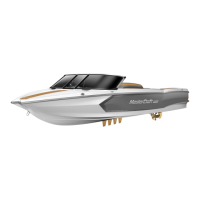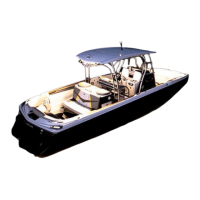AVIARA OWNERS MANUAL / 230
determine whether any leaks are apparent.
Step 1
First ensure that the engines are OFF and that the engine safety
starting switch is disconnected. Be certain that the throttle/shift
control levers are in neutral. The engines must be cool.
Step 2
Open the engine compartment and note whether there is
any unusual odor. In many instances, exhaust will have little
or no odor, but in the event of a potentially significant exhaust
leakage, it may be possible to smell a “rotten-egg” odor that
signifies a probable issue that must be addressed.
Step 3
If leakage is apparent, tighten the hose clamps, being careful
to avoid crimping the hose. If the leakage is significant, or is
occurring at a location other than the joints (such as a split in a
hose), see your authorized Aviara dealer’s service department
for parts and service.
Exhaust fumes can cause illness or impairment, including carbon
monoxide poisoning. Equally important to consider, leakage can
lead to a build-up of potentially explosive fumes within the engine
compartment.
to the engines as you can see. On some models this is will
be a limited area. If the odor of gasoline is strong or if you see
visual evidence of fuel outside the system, cease all operations
and take the boat immediately to an authorized Aviara dealer’s
service department to determine the source of the leak. The
leak must be repaired before the engine is restarted.
The engine box serves as a machinery guard. The engines must be
OFF whenever the box is open. Clothing or body parts can get caught
in moving parts, causing death or serious injury. Keep away from
moving parts!
Fuel leakage can lead to a build-up of potentially explosive fumes
within the engine compartment. DO NOT IGNORE OR OVERLOOK
THIS INSPECTION AND REPAIR AS NECESSARY!
Note Any Exhaust
Odors
This function should be performed prior to starting the engines;
and then again after about three (3)-to-five (5) minutes to

